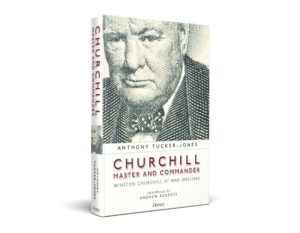Finest Hour 162
Books, Arts & Curiosities – Matters of Interpretation

Winston Churchill, Parliament Square, London © Sue Lowry & Magellan PR
February 18, 2015
Finest Hour 162, Spring 2014
Page 47
By William John Shepherd
Churchill’s Bomb: How the United States Overtook Britain in the First Nuclear Arms Race, by Graham Farmelo. Basic Books, 576 pages, $29.99, Kindle $14.99, member price $24.
This book is a partial sequel to the author’s 2009 biography, Paul Dirac: Mystic of the Atom, a collective biography of the mostly-British protégés of pioneering Cambridge physicist Ernest Rutherford; their work in developing nuclear weapons with leaders like Churchill; and Britain’s relations over atomic matters with Presidents Roosevelt, Truman, and Eisenhower. The earlier book could have been titled Churchill and the Scientists, like the BBC docu-drama Churchill and the Generals, depicting WSC’s adversarial relationships with his experts. In the Dirac, Churchill is quoted saying “scientists should be on tap, not on top” (320). Churchill’s Bomb puts the scientists “on top.”
Farmelo argues that Churchill the political leader lacked the foresight of Churchill the writer. While no academic, Churchill was a critical thinker who tried to keep abreast of technological advances. The statesman’s articles, “Shall We All Commit Suicide?” (1924) and “Fifty Years Hence” (1931), provocatively asked whether nuclear energy would provide vast new sources of energy, or gravely jeopardize humanity unless controlled through spiritual and moral development (43).
Alas, Farmelo continues, after Churchill became prime minister he squandered Britain’s scientific lead to the Americans, in part because he had to focus on short-term, practical military means to survive the Nazi onslaught—while the U.S., safe across the Atlantic, had more time, space and resources to develop nuclear weapons.
Churchill is criticized for favoring one scientist, his friend “The Prof,” Frederick Lindemann (later Lord Cherwell) over all the others. The PM loved Lindemann’s brief, cogent, jargon-free summaries of complicated scientific ideas, Farmelo writes, but was unaware or unconcerned that The Prof was alienated from many colleagues because of his abrasive manner and “confused thinking about space and time in quantum theory” (48).
Repeatedly Farmelo cites the PM’s and Lindemann’s weakness for “gadgets” which offered at best only slight military advantage—counter to the thesis of David Edgerton in Britain’s War Machine (FH 155). The Nobel Prize-winning Danish physicist Niels Bohr, whom Farmelo calls an “honorary Brit” (281), was “a man of exceptional wisdom” (7) who was shabbily treated by Churchill and Roosevelt. Bohr’s exceptional wisdom proposed sharing atomic secrets with the Soviets, which some have suggested would have avoided a postwar arms race, a chimeric notion that gets more credit than it deserves.
Churchill, Farmelo continues, was unable to deal effectively with the American presidents. After Pearl Harbor, Roosevelt offered Britain participation in a joint nuclear project, but Churchill wasted months in responding, missing “the great opportunity given to him by his nuclear scientists” (203). By June 1942 they had agreed to work on equal terms, though within months the Americans were restricting exchanges of information. In August 1943, we read, Churchill belatedly understood the importance of the bomb—odd, given what he had written about it in 1924. Thus WSC secured another agreement that information would flow, and that neither power would use the bomb without approval of the other. This agreement too eventually fell apart. Britain, Farmelo concludes, would have been better served had Churchill accepted the original 1941 offer. But how good was that, given Farmelo’s descriptions of Roosevelt as “slippery” (189) and “unreliable” (226)?
After Roosevelt’s death, Churchill approved Truman’s use of the bomb to end the war. He then left office to become what Farmelo considers a “weak and ineffective” leader of the opposition (332), writing war memoirs with “misremembered anecdotes, unqualified praise for the Prof, and no personal regrets” (341).
Evoking the image of Churchill as warmonger, circulated by his enemies many times over fifty years, the author dwells on Churchill’s (momentary and private) contemplation of a preemptive nuclear strike on the Soviets. Once the Soviets acquire the bomb in 1949, however, Churchill becomes obsessed with the prospect of a nuclear Armageddon. Prime Minister again in late 1951, he undertakes a quixotic crusade as a peacemaker, promoting a grand summit with the Americans and Soviets—fruitless efforts which, says Farmelo, did little more than annoy the parties involved, including his own government.
The book is well written, with thirty-five unnumbered chapters, effectively fusing science and history, despite some idiosyncratic vocabulary, such as “wheezes” (115), “cadged” (247), and “frenemy” (338). Unlike the English edition there are no illustrations, though credible sources are referenced. The result is an ambivalent work providing a good account of the development of nuclear weapons from the perspective of the mostly left-leaning scientists, along with a polemic against Churchill and Lindemann.
Given the hand he had to play, and the predilections of his partners in the White House, we might wonder: what else could Churchill have done? But hindsight is cheap and easily indulged. One of the few things Churchill and The Prof got right, Farmelo concludes, was the postwar establishment of Churchill College Cambridge (the British MIT), where the author is a fellow, and which houses the papers of Churchill and many of the scientists involved in the story.
Mr. Shepherd is Associate Archivist of The Catholic University of America in Washington, D.C.
Subscribe
WANT MORE?
Get the Churchill Bulletin delivered to your inbox once a month.






